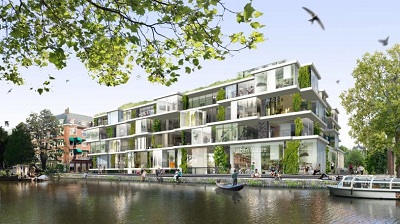 Friday, July 26, 2024
Friday, July 26, 2024  Friday, July 26, 2024
Friday, July 26, 2024 
As blogged on FastCompany.com, when you picture a green roof, you probably see a perfectly manicured space, like a skyscraper got a flat top and dyed it green. No doubt, such green roofs are beautiful, and they’re also superb for cooling buildings and mitigating rainfall. But they’re a version of nature that’s every bit as tamed as your average suburban lawn. It’s more urban than wild.
The landscape architects at Buro Harro, in collaboration with Bastiaan Jongerius, Ronald Janssen, and DGMR, are imagining a different type of green roof atop Amsterdam’s forthcoming Groenmarkt apartment building. “It will become a hilly, sandy dune landscape with dune-grasses and other plants growing there,” writes studio founder Harro de Jong over email. “With a salty swimming pool in the middle of it.”
As Harro explains, “The weather in the Netherlands isn’t always that great. Especially on a roof. It’s even more windy and chilly than it usually is. So we thought: why not talk a landscape that perfectly matches these windy circumstances, where everybody loves to go even on a windy, stormy or rainy day: the coast, the dunes!” Harro isn’t wrong. Dunes are a specific type of beach experience, not one necessarily promising coconut drinks and sunburns, but one that can scratch a certain existential itch. Dunes provide the feeling that you’re surrounded by a natural world far greater than yourself–and it’s hard to imagine a better cure to city life than that.
Practically speaking, dunes make a lot of sense for roofs, too. Dune grass–and specifically, the species ammophila arenaria being used in this project–doesn’t need much maintenance. It handles high winds well because it evolved to do just that. And its root systems help stabilize the the sand and maintain its hilly shape. “Small trees we plant in the direction of the prevailing winds will finish the real dune-feeling,” says Barro. “The sounds of Amsterdam on the background will be like the murmuring sea on the background.”
Watch the video and learn more about Construction Links Network – the peer-to-peer network sharing platform for the construction, building and design community.
Ideal for YOUR Press Releases | Project Updates | New Appointments | Awards & Milestones | Company News | New Products/Services | Brochures | Videos | Infographics | Blog Sharing | Events and More